The Electronic Intifada 31 July 2006
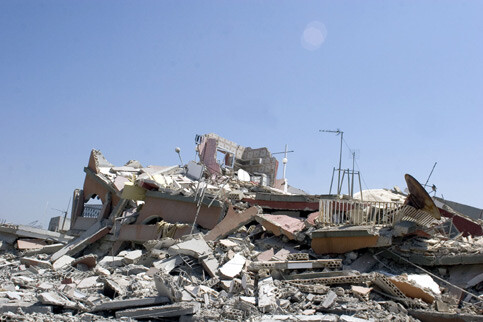
A general view of devastated Qana, 31 July 2006. (MaanImages/Raoul (MaanImages/Raoul Kramer)
Sunday, 30 July 2006, while US Secretary of State Condoleezza Rice was in Jerusalem to meet with Israeli Prime Minister Ehud Olmert, a US-manufactured weapon was dropped by Israeli-manned fighter jets on a residential building in Qana, southern Lebanon. Over 50 civilians perished, most of them children. No arms were found in the building. The village was the site of another massacre ten years ago, when Israel struck a UN post sheltering civilians. That time, over 100 died.
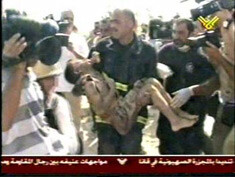
Al-Manar screenshot of the Qana rescue and recovery operation
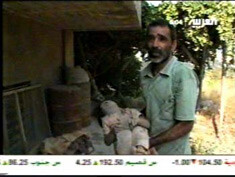
Al-Arabiya screenshot of the Qana rescue and recovery operation
Human Rights Watch condemned the strike, and stated that responsibility “rests squarely with the Israeli military,” and emphasized that the “consistent failure to distinguish combatants and civilians is a war crime.”

Al-Jazeera screenshot of the Qana rescue and recovery operation
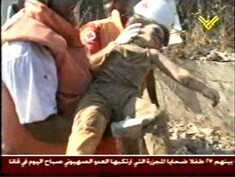
Al-Manar screenshot of the Qana rescue and recovery operation
The Israeli military issued a statement placing responsibility for the deaths on Hezbollah, as “residents in the region and specifically the residents of Qana were warned several days in advance to leave the village,” and it claimed that Hezbollah launched rockets from the area. However, Israel has repeatedly struck the vehicles of civilians fleeing the besieged south, prompting many in Lebanon’s poor south to remain. Human Rights Watch further refuted this argument, stating, “Just because the Israeli military warned the civilians of Qana to leave does not give it carte blanche to blindly attack.”

Lebanese refugees fleeing to the northern villages in Lebanon after Israeli raids on southern villages, 31 July 2006. (MaanImages/Raoul Kramer)
Many in the international community were quick to react to the deaths. The French ambassador to the United Nations said Sunday, “The Security Council expresses its extreme shock and distress at the shelling by the Israeli Defense Forces of a residential building in Qana … .” The United Nations High Commissioner of Human Rights Louise Arbor said on Monday, “I strongly condemn the killing of dozens of civilians, among whom a very high proportion were children … .”
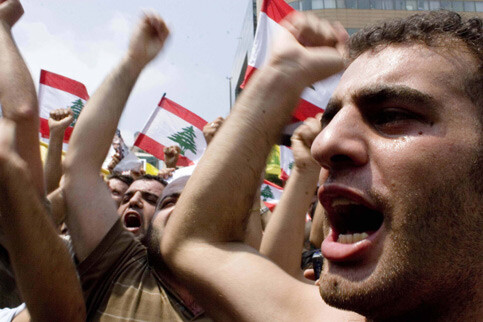
Lebanese protesters demonstrate in front of the UN headquarters in Beirut, 30 July 2006 after Israel’s deadly air strike on Qana. (MaanImages/Raoul Kramer)
The massacre prompted demonstrations throughout the Middle East, and some 2,000 Lebanese demonstrators outside the UN House in Beirut protested, and some managed to break into the building and cause damage before being dissuaded by Hezbollah clerics. Marking the strike as a dangerous escalation of the conflict, Hezbollah vowed to avenge the attack, as did the Palestinian Islamic resistance group Hamas, while Syria said that it was readying its military in response to “regional challanges.”

Palestinians demonstrate in the West Bank city of Ramallah against the Israeli offensive in Qana, 30 July 2006. (MaanImages/Mushir Abdelrahman)
Lebanese Prime Minister Fouad Siniora called for an “immediate and unconditional ceasefire,” changing his previous public stance towards Hezbollah by thanking the resistance group for its “sacrifices” defending the nation. Meanwhile, the country’s acting Foreign Minister Tarek Mitri said, “The spilled blood of the children in Qana deserves more, much more, than expressions of regret.”
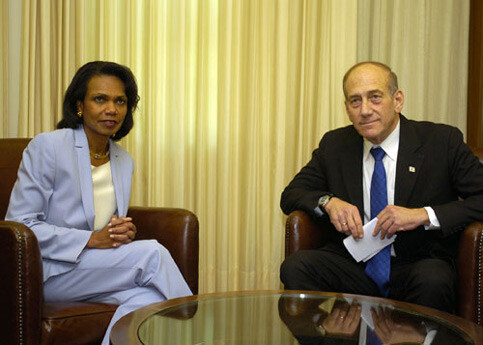
US Secretary of State Condoleezza Rice with Israeli Prime Minister Ehud Omert, 30 July 2006, the day of the deadly strike at Qana (State Dept. photo/David Azagury)
However, the US struggled to come up with even that. While he said that “we mourn the loss of innocent life,” US President Bush asserted that “Israel is exercising its right to defend itself,” and that “it’s important to remember this crisis began with Hezbollah’s unprovoked terrorist attack against Israel,” referring to Hezbollah’s capture of two Israeli soldiers on 12 July. The US’s ambassador to the United Nations John Bolton said, “what we are going to try to do today is to see if we can agree on a presidential statement or press statement that will express our profound regrets and condolences to the families of those who have died and things along those lines.” He added that he believed that the Israeli envoy’s expression of regret to the UN Security Council “was a sincere expression of regret.”
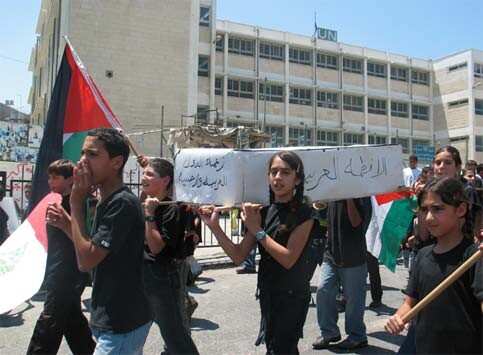
Children in Deheisheh Refugee Camp demonstrate against Israeli violence against children in Palestine and Lebanon. Some of the demonstrators carried pictures of Qana’s victims, 31 July 2006 (Ibdaa Cultural Center)
The US did announce on Sunday a 48-hour cessation of air force operations by the Israeli military. However, the following day, Israeli air forces resumed their activity over the sovereign nation of Lebanon. The Israeli daily Ha’aretz reported, “The Prime Minister’s Bureau clarified Monday night that Sunday night’s announcement regarding a 48-hour suspension of air strikes is not a cease-fire. Bureau officials said the ground operation is continuing, and expanding, and the air force has been instructed to attack any target that appears to be a threat to Israel. The air force also has license to attack identified Hazbollah personnel.”

Palestinians demonstrate in the West Bank city of Ramallah against the Israeli offensive in Qana, 30 July 2006. (MaanImages/Mushir Abdelrahman)
Israeli statements make it clear that the Jewish state has no intention of exercising “maximum restraint” as British Prime Minister Blair called for after the massacre. Israel has insisted that “the Israeli Defence Forces dropped leaflets and warned the civilian population to leave the place because Hezbollah turned it into a war zone,” as expressed by Israeli Foreign Ministry official Gideon Meir. And last week, Israeli Justice Minister Haim Ranen asserted, “everyone in southern Lebanon is a terrorist and is connected to Hezbollah.”
US President Bush spoke with similarly black-and-white platitutdes about the ongoing violence in Lebanon. “The current crisis is part of a larger struggle between the forces of terror in the Middle East,” Bush declared after the massacre. Both the US and Britian continued to stand alone with Israel, refusing to call for an immediate cease-fire.
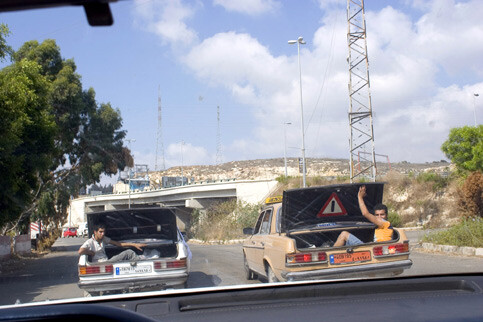
Lebanese refugees fleeing to the northern villages in Lebanon after Israeli raids on southern villages, 31 July 2006. (MaanImages/Raoul Kramer)
Bolton also reiterated the Bush administration’s stance against calling for a cease-fire, explaining, “our view has been that we need to work toward a permanent solution to problems in the region.”
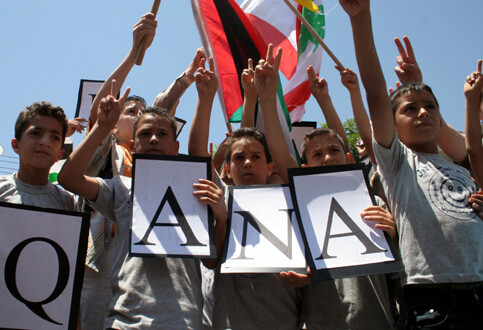
Palestinian children demonstrate during a rally in the West Bank city of Hebron against the Israeli offensive at Qana, 31 July 2006. (MaanImages/Mamoun Wazwaz)
Meanwhile, Israel’s claim that Qana was an error has not placated all observers, as the international community grows increasingly concerned over the protection of civilians. “ ‘Qana was not a mistake,’” Human Rights Watch’s Peter Bonhaert told Salon, adding, “ ‘It was not an accident. It was the natural outcome of a policy of not distinguishing between civilian and military targets.’”
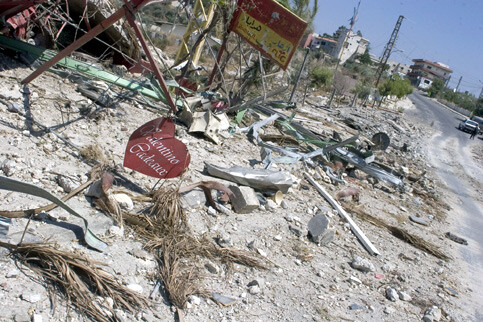
Debris at devastated Qana, 31 July 2006. (MaanImages/Raoul (MaanImages/Raoul Kramer)
While Lebanon was recovering and burying the dead, Olmert said on Monday to roaring applause in Tel Aviv, “There is no cease-fire and there will not be a cease-fire in the upcoming days,” adding that Israel “should be ready for pain, tears and blood.” However, Lebanon has been feeling that pain and shedding that tears and blood for some time now, while the US, Britain, and Israel ensure that Lebanon’s civilians bear that brunt.
Related Links
The text accompanying this photostory was written by Maureen Clare Murphy, Arts, Music & Culture Editor for the Electronic Intifada